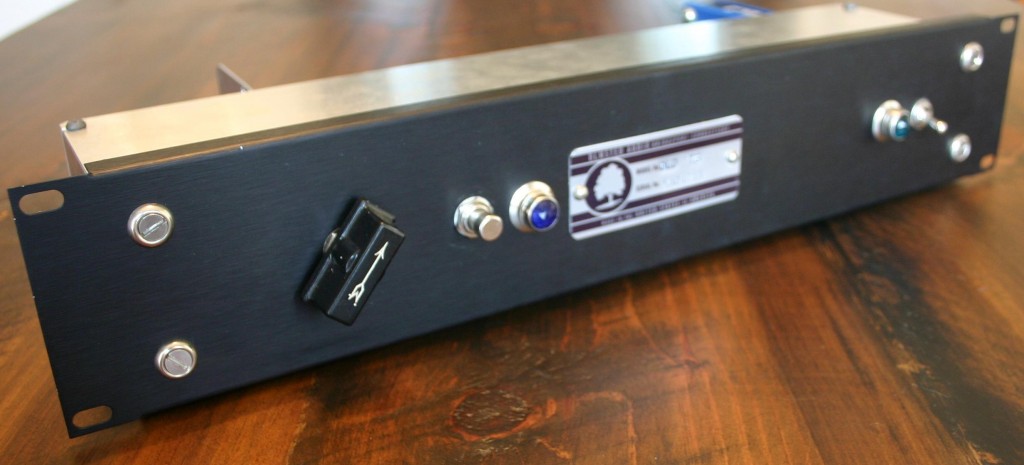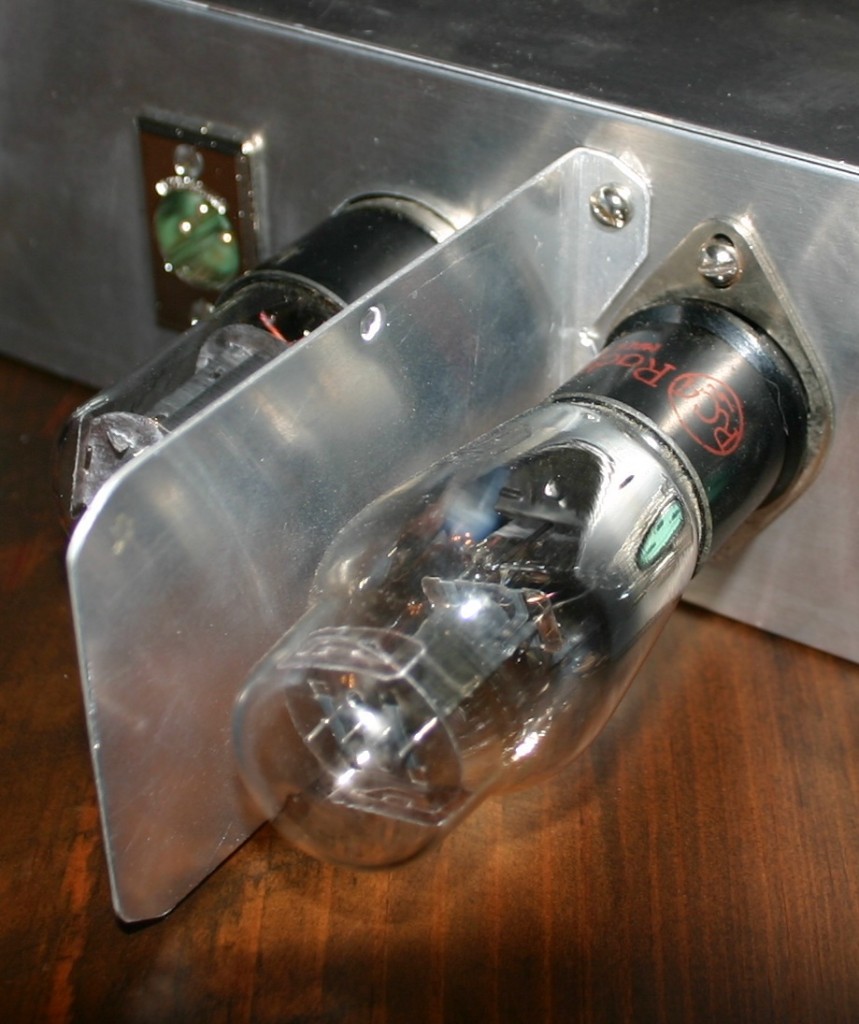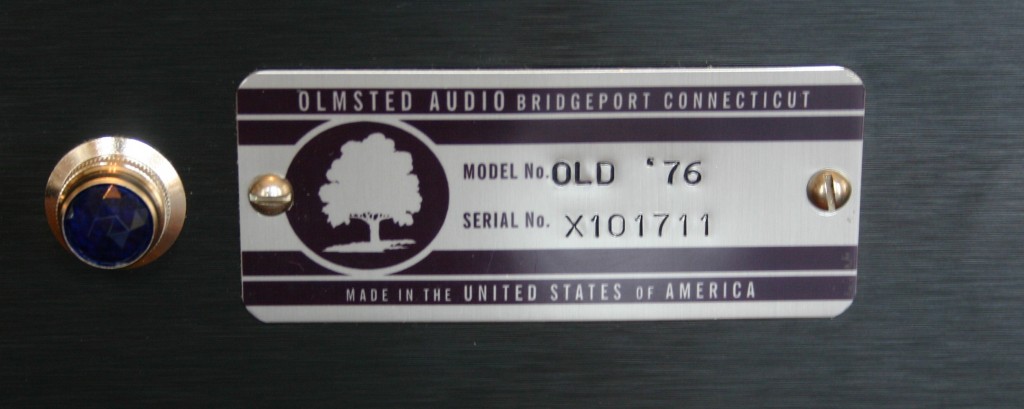 My latest microphone preamp design is completed and sounding very cool… The Old ’76.
My latest microphone preamp design is completed and sounding very cool… The Old ’76.
 The Old ’76 is a novel three-stage design; it’s not based on any past or current production microphone preamp. That being said, the circuit is nothing revolutionary: an input transformer (in this case a UTC O-1, as I was temporarily out of Jensen 115s) connects to an RCA 76 tube, biased in textbook (or, at least, RCA-Receiving-Tube-Manual-book) fashion; volume pot follows and then on to a 6SL7 tube with the first stage plate directly coupled to the grid of triode 2; the output is a cathode follower with a Solen cap and onto an Edcor output transformer. The pushbutton switch (with associated pilot lamp) activates 48V phantom power. Overall gain is approx. 60db and response is flat 50hz – 18khz. I am betting that the slight high and low end roll off is due to the UTC O-1; the next build will use my customary Jensen input transformer and we should see 25hz-20khz flat response.
The Old ’76 is a novel three-stage design; it’s not based on any past or current production microphone preamp. That being said, the circuit is nothing revolutionary: an input transformer (in this case a UTC O-1, as I was temporarily out of Jensen 115s) connects to an RCA 76 tube, biased in textbook (or, at least, RCA-Receiving-Tube-Manual-book) fashion; volume pot follows and then on to a 6SL7 tube with the first stage plate directly coupled to the grid of triode 2; the output is a cathode follower with a Solen cap and onto an Edcor output transformer. The pushbutton switch (with associated pilot lamp) activates 48V phantom power. Overall gain is approx. 60db and response is flat 50hz – 18khz. I am betting that the slight high and low end roll off is due to the UTC O-1; the next build will use my customary Jensen input transformer and we should see 25hz-20khz flat response.
 76 tubes were often used in ancient console radios with a large tubular shield positioned around them; the reason for this became quiet clear once I had finished my piece; before I added the above-depicted aluminum plate between the 76 and 6SL7, I was getting some unpleasant ringing on very high frequencies.
76 tubes were often used in ancient console radios with a large tubular shield positioned around them; the reason for this became quiet clear once I had finished my piece; before I added the above-depicted aluminum plate between the 76 and 6SL7, I was getting some unpleasant ringing on very high frequencies.
I had wanted to build a mic pre with some of these very old two-digit designation tubes for some time now. Hi-Fi fans seem to love the 76 tube, so I figured there was probably something worth investigating. 76 tubes are readily available and pretty inexpensive; it is a bit of a challenge to find the 5-pin bases that they require though. AES sells only one 5-pin base, and it’s expensive and oversized. My prototype unit here used an older Amphenol socket that I dug up somewhere.
 Some other miscellaneous design notes: B+ rectifier is a 6×5 tube; hammond 15mh choke was used in the B+ chain; DC filaments, as usual; the phantom power supply has a slow ramp-up when activated; the three-pole phantom switch 1)connects the 48v supply to the main power supply; 2)connects the phantom indicator lamp to the 6v supply; and 3) connects the 48v to 6.8k resistors that actually connect to the mic input jack. I find a three-pole switch necessary in these instances because there is some ‘drain’ time involved when phantom is turned off, even with a bleeder resistor; disconnecting the 48v right before it hits the mic jack provides 100% assurance that you (I) won’t melt that BK5 ribbon (again).
Some other miscellaneous design notes: B+ rectifier is a 6×5 tube; hammond 15mh choke was used in the B+ chain; DC filaments, as usual; the phantom power supply has a slow ramp-up when activated; the three-pole phantom switch 1)connects the 48v supply to the main power supply; 2)connects the phantom indicator lamp to the 6v supply; and 3) connects the 48v to 6.8k resistors that actually connect to the mic input jack. I find a three-pole switch necessary in these instances because there is some ‘drain’ time involved when phantom is turned off, even with a bleeder resistor; disconnecting the 48v right before it hits the mic jack provides 100% assurance that you (I) won’t melt that BK5 ribbon (again).
An A/B test of The Old ’76 vs. the usual API 512 will be posted here in the next month or so.
21 replies on “The Old ’76”
Hi Chris,
Indeed, these ancient triodes are wonderful, obscure candidates and often overlooked when building gear.
Usually people rely upon the 12AX7/12AU7 range or their octal-based cousins, the 6SL7/6SN7 variety. But I like the old 5-pin based triodes a lot better.
A while ago I built a line-driver with the RCA UY-227 to be part of my monitoring chain. The 227 (or 27) was the first series-produced indirectly-heated triode and introduced to the public in 1927. It has a fat globe-shaped bulb and a mesh plate. Beautiful RCA logo on top. Quite a sight.
And then there is the sound. It just blows you away. If you hear what this dinosaur can do to, say, the tone of a Martin 6-string, or any other decently recorded acoustic, it’s just breath-taking. Setting up a three-dimensional soundstage is another forte of this tube. In fact there’s no going back to a 12AU7 or even a 6SN7 once you’ve been exposed to the 27; they sound dull and gray by comparison.
The only downside I can think of with the 27 is that some samples can be microphonic, so isolating them and shielding is a good idea.
In getting the best from these tubes sound-wise, it’s mandatory that the rest of the components perform at the same level, especially the coupling caps between stages.
Here I always use paper-in-oil types for ultimate smoothness. Really pays off.
Love your site!
All the best,
Kees
Chris,
I have 8 triad / utrad A-11j input transformers, and I am trying to decide on a mic preamp design for my studio. These things are incredible as I have built a pentode design that sounded fantastic. Any suggestions on a design? triode? pentode?
joel
yeah those are great, I have one sittin around myself, it’ll end up in something soon enough! RE: mic preamp circuits, I love my EMI Redd47. Slightly more complex build than most. I also really really really love the RCA BA-2C, but keep in mind that you will need a very special output trans for that one – A-25 or similar model that can handle 8ma unbalanced DC. good luck. c.
Hi Joel, I’d like to buy your A-11j’s please email or call me. Thanks, Don 805 450 8760.
This is a great looking unit! I wish I had the skills to make one! Where does the +48v come from? The Edcor transformer?
Yes- i make a shunt-regulated 48v supply using two 24v zeners in series. It is fed from the rectifier output and has its iwn filtering. C.
Ah is that where it comes from! I’m just a curious electronics amateur, and all the tube pre’s schematics I’ve looked at never seem to include a phantom power line.
I have this really crappy Behringer ‘tube’ pre, and its a wild ambition to steal the tube from it and build a better one.
If u r serious, start by cloning an altec 1566. Trust me- thats the cheapest eastiest one to build. Use a jensen 1:10 shielded input and edcor output and power trans. Good luck. C.
Thanks Chris that’s helpful to me. I’ll send you a picture when I finish it (not if).
Thanks again
Hey Chris,
Im almost finished my Altec 1566 and its been a blast, but I just cant seem to ‘get away’ with my edcor output tranny. It’s picking up some serious hum from the PT (hammond 369ex). I actually rebuilt the unit twice because I suspected I had made a grave error somewhere, but I experimented with a shielded input tranny (sowter 4883f) – as the output – and the problem hum went away.
Have you ever found the Edcor or any other unshielded trans to be a problem in this way? Its a bit of a shame because the Sowter unit is £65 and as you know the Edcors are considerably cheaper…
hey John. I can tell you for absolute certain that the edcor unsheilded 15K:600 O/T is a good choice. I have used these $10.22 units in a TON of preamps that I use everyday alongside Neves, APIs, etc., and they sound great.
A couple of suggestions for you:
*When using transformers that are NOT magnetically-shielded (like EDCORs), orientation and proximity to hum-0emiting coils (EG yr power trans) are major factors!!! Did you put yr O/T near your P/T? Did you do a ‘headphone orientation test’ on both sides of the yr O/T while running current thru yr P/T? This is crucial to layout of any tube audio device. BTW, the same thing holds thru of chokes as it does of O/Ts.
check this:
http://www.ax84.com/bbs/dm.php?thread=294227
*a second, minor note – you chose a very big P/T (75ma on the B+ winding). A smaller unit would be more suitable, and cheaper.
good luck,
c.
Thanks for the advice. Using the headphone trick I found if the Edcor was on its side the problem went away! I’ve fabricated an L-shaped bracket and I’m back in business.
Just have a weird oscillation/gain drop out thing going on when the knob is at 3/4, but hey ho…
Thanks again Chris
Hey john. The problem u r experiencing is called parasitic oscillation. Assuming yr device is wired correctly, this is caused by improper layout and or lead-length. You can research this online. Or just use a 12ay7 in the first stage, that might cure it too.
Cured. I had stupidly long leads to the first grid that seemed to be picking up NASA signals.
Yup,,, keep all low-level high-impedance runs very short!
c.
Hi Chris!
This project is really interresting to me, with theese 76s.
Maybe you could help me with sharing the schematics of yours?
I’ve already built the Altec 1566 and it sounds amazing to me on vocals. Now i’m want to build something like it (no NFB loop) with a 76 on the first stage and two 6sl7s on the second and third stages to compensate the old tubes lower mu and somehow get the same gain as the 1566 (cca. 65db). I am curious if you do something simmilar on this project? If you could help me some resistor/cap values and voltages I mutch appriciate it.
Pete
hi pete. I don’t have a unified schematic for this thing. I work from the RCA receiving tube manuals. I’d be happy to make a schematic for you but there would be some cost involved, since i don’t have/need one personally. BTW, One 76 and one 6SL7 will give you around 65 db of gain including the 1:10 input trans and accounting for losses in a 5:1 output trans. You def do not need two. that would be way too much gain. Good luck, c.
hi Chris,
thank you for your hints! I have the very same UTC O-1 as you wich is 1:15 as I recall and Altec 15095 wich is 5:1 on 600ohms. It’s sill a mistery to me how could 3 lower gain triode stages deliver the same amount of gain with same type of xformers, in simmilar circuit…because 12AX7’s gain is 100, 6SL7 has 70, and 76 has only 13(!). Or maybe the 1566’s given max.65db gain is with 600ohm termination load? If so, on modern high impedance equipment means no load and give much more gain. You mentioned you got around 60db on your 76/6SL7 preamp. Is it on 600ohm or without load? Thank you for your kind help!
P
I can’t help you with this man sorry. I am not an EE. Run it thru SPICE if you like. in the 1566 there are only three positive gain stages (the I/T, stage 1 and 2). The output stage is approx. unity gain and the O/T is about 8db loss. Don’t get hung up on the termination issue. I really can’t offer any more help. Good luck. c.
also don’t confuse DB gain with ‘amplification factor’
they are not the same thing.
good luck
c.
You already help me lot chris! Thanks! And you are right with db/ voltage amplification thing too. Keep up the good work
gl
P